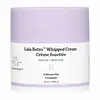What's inside
What's inside
 Key Ingredients
Key Ingredients

 Benefits
Benefits

 Concerns
Concerns

 Ingredients Side-by-side
Ingredients Side-by-side

Water
Skin ConditioningGlycerin
HumectantEthylhexyl Palmitate
EmollientParaffinum Liquidum
EmollientCetearyl Alcohol
EmollientStearyl Stearate
EmollientPetrolatum
EmollientBeeswax
Emulsion StabilisingPEG-100 Stearate
Theobroma Cacao Seed Butter
EmollientRosa Damascena Flower Water
MaskingSaccharomyces Polypeptides
Skin ConditioningTremella Fuciformis Polysaccharide
Emulsion StabilisingCarbomer
Emulsion StabilisingPolyacrylamide
C13-14 Isoparaffin
EmollientLaureth-7
EmulsifyingButylene Glycol
HumectantEthylhexylglycerin
Skin ConditioningCaprylhydroxamic Acid
Sodium Hydroxide
BufferingPhenoxyethanol
PreservativeWater, Glycerin, Ethylhexyl Palmitate, Paraffinum Liquidum, Cetearyl Alcohol, Stearyl Stearate, Petrolatum, Beeswax, PEG-100 Stearate, Theobroma Cacao Seed Butter, Rosa Damascena Flower Water, Saccharomyces Polypeptides, Tremella Fuciformis Polysaccharide, Carbomer, Polyacrylamide, C13-14 Isoparaffin, Laureth-7, Butylene Glycol, Ethylhexylglycerin, Caprylhydroxamic Acid, Sodium Hydroxide, Phenoxyethanol
Water
Skin ConditioningGlycerin
HumectantCaprylic/Capric Triglyceride
MaskingIsopropyl Isostearate
EmollientPseudozyma Epicola/Camellia Sinensis Seed Oil Ferment Extract Filtrate
HumectantGlyceryl Stearate Se
EmulsifyingCetearyl Alcohol
EmollientPalmitic Acid
EmollientStearic Acid
CleansingPentylene Glycol
Skin ConditioningPlantago Lanceolata Leaf Extract
AntimicrobialAdansonia Digitata Seed Oil
EmollientCitrullus Lanatus Seed Oil
EmollientPassiflora Edulis Seed Oil
EmollientSchinziophyton Rautanenii Kernel Oil
EmollientSclerocarya Birrea Seed Oil
HumectantXimenia Americana Seed Oil
EmollientCholesterol
EmollientCeramide AP
Skin ConditioningCeramide EOP
Skin ConditioningSodium Hyaluronate Crosspolymer
HumectantCeramide NP
Skin ConditioningPhytosphingosine
Skin ConditioningCeteareth-20
CleansingTrisodium Ethylenediamine Disuccinate
Tocopherol
AntioxidantSodium Lauroyl Lactylate
EmulsifyingSodium Hydroxide
BufferingCitric Acid
BufferingCarbomer
Emulsion StabilisingXanthan Gum
EmulsifyingCaprylyl Glycol
EmollientSodium Chloride
MaskingSodium Carbonate
BufferingChlorphenesin
AntimicrobialPhenoxyethanol
PreservativeEthylhexylglycerin
Skin ConditioningWater, Glycerin, Caprylic/Capric Triglyceride, Isopropyl Isostearate, Pseudozyma Epicola/Camellia Sinensis Seed Oil Ferment Extract Filtrate, Glyceryl Stearate Se, Cetearyl Alcohol, Palmitic Acid, Stearic Acid, Pentylene Glycol, Plantago Lanceolata Leaf Extract, Adansonia Digitata Seed Oil, Citrullus Lanatus Seed Oil, Passiflora Edulis Seed Oil, Schinziophyton Rautanenii Kernel Oil, Sclerocarya Birrea Seed Oil, Ximenia Americana Seed Oil, Cholesterol, Ceramide AP, Ceramide EOP, Sodium Hyaluronate Crosspolymer, Ceramide NP, Phytosphingosine, Ceteareth-20, Trisodium Ethylenediamine Disuccinate, Tocopherol, Sodium Lauroyl Lactylate, Sodium Hydroxide, Citric Acid, Carbomer, Xanthan Gum, Caprylyl Glycol, Sodium Chloride, Sodium Carbonate, Chlorphenesin, Phenoxyethanol, Ethylhexylglycerin
 Reviews
Reviews

Ingredients Explained
These ingredients are found in both products.
Ingredients higher up in an ingredient list are typically present in a larger amount.
Carbomer is a polymer of acrylic acid. Its main role is to create a gel consistency.
A high amount of carbomer can cause pilling or balling up of products. Don't worry, most products contain 1% or less of carbomer.
Cetearyl alcohol is a mixture of two fatty alcohols: cetyl alcohol and stearyl alcohol. It is mainly used as an emulsifier. Emulsifiers help prevent the separation of oils and products. Due to its composition, it can also be used to thicken a product or help create foam.
Cetearyl alcohol is an emollient. Emollients help soothe and hydrate the skin by trapping moisture.
Studies show Cetearyl alcohol is non-toxic and non-irritating. The FDA allows products labeled "alcohol-free" to have fatty alcohols.
This ingredient is usually derived from plant oils such as palm, vegetable, or coconut oils. There is debate on whether this ingredient will cause acne.
Due to the fatty acid base, this ingredient may not be Malassezia folliculitis safe.
Learn more about Cetearyl AlcoholEthylhexylglycerin (we can't pronounce this either) is commonly used as a preservative and skin softener. It is derived from glyceryl.
You might see Ethylhexylglycerin often paired with other preservatives such as phenoxyethanol. Ethylhexylglycerin has been found to increase the effectiveness of these other preservatives.
Glycerin is already naturally found in your skin. It helps moisturize and protect your skin.
A study from 2016 found glycerin to be more effective as a humectant than AHAs and hyaluronic acid.
As a humectant, it helps the skin stay hydrated by pulling moisture to your skin. The low molecular weight of glycerin allows it to pull moisture into the deeper layers of your skin.
Hydrated skin improves your skin barrier; Your skin barrier helps protect against irritants and bacteria.
Glycerin has also been found to have antimicrobial and antiviral properties. Due to these properties, glycerin is often used in wound and burn treatments.
In cosmetics, glycerin is usually derived from plants such as soybean or palm. However, it can also be sourced from animals, such as tallow or animal fat.
This ingredient is organic, colorless, odorless, and non-toxic.
Glycerin is the name for this ingredient in American English. British English uses Glycerol/Glycerine.
Learn more about GlycerinPhenoxyethanol is a preservative that has germicide, antimicrobial, and aromatic properties. Studies show that phenoxyethanol can prevent microbial growth. By itself, it has a scent that is similar to that of a rose.
It's often used in formulations along with Caprylyl Glycol to preserve the shelf life of products.
Sodium Hydroxide is also known as lye or caustic soda. It is used to adjust the pH of products; many ingredients require a specific pH to be effective.
In small amounts, sodium hydroxide is considered safe to use. However, large amounts may cause chemical burns due to its high alkaline.
Your skin has a natural pH and acid mantle. This acid mantle helps prevent harmful bacteria from breaking through. The acid mantle also helps keep your skin hydrated.
"Alkaline" refers to a high pH level. A low pH level would be considered acidic.
Learn more about Sodium HydroxideWater. It's the most common cosmetic ingredient of all. You'll usually see it at the top of ingredient lists, meaning that it makes up the largest part of the product.
So why is it so popular? Water most often acts as a solvent - this means that it helps dissolve other ingredients into the formulation.
You'll also recognize water as that liquid we all need to stay alive. If you see this, drink a glass of water. Stay hydrated!
Learn more about Water